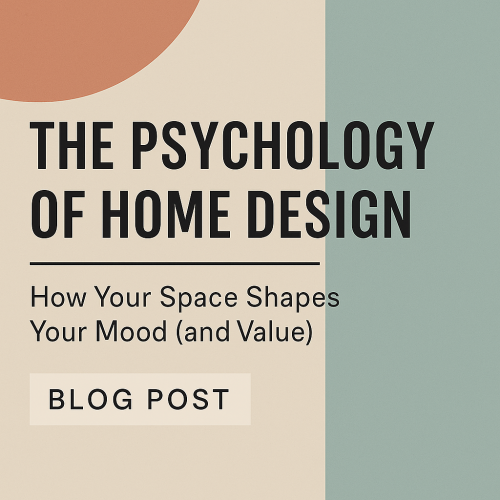The Psychology of Home Design: How Your Space Shapes Your Mood (and Value)
When most people think about buying or designing a home, they focus on square footage, layout, or location. But there’s another factor that plays a huge role in how we feel in our living spaces — the psychology of home design. The way a home looks, feels, and flows doesn’t just affect its value on the market; it affects your daily mood, productivity, and even relationships.
1. The Power of Colour
Colour has a profound effect on how we feel. Warm tones like reds and oranges can energize a space, making them great for kitchens or dining areas where conversation and activity are encouraged. Cooler tones, like blues and greens, promote calmness and are perfect for bedrooms or bathrooms.
If you’re selling, neutral tones often work best. They help buyers picture themselves in the home and make rooms feel larger. However, subtle pops of colour — a muted blue accent wall or warm mustard in a reading nook — can create emotional connection without overpowering.
2. Light Is the Unsung Hero
Natural light is one of the most powerful mood boosters. Sunlight regulates our circadian rhythm, improves focus, and reduces stress. A room flooded with daylight will almost always feel more inviting than one lit solely by artificial bulbs.
For sellers, maximizing light can mean rearranging furniture, swapping heavy curtains for sheer panels, or strategically placing mirrors to reflect sunlight deeper into the room. Even small lighting changes can shift a space from “closed in” to “open and airy.”
3. Flow and Function
Ever walked into a home where the furniture blocks pathways or the kitchen feels boxed in? That’s poor spatial psychology at work. Our brains crave movement and easy navigation. Open layouts encourage social interaction and make spaces feel bigger. Even in smaller homes, thoughtful placement of furniture can create a sense of openness.
When staging a home, less is often more — removing unnecessary pieces helps the mind register a cleaner, calmer space.
4. Texture and Touch
The feel of a home isn’t just visual; it’s tactile. Soft throws, natural wood grains, and plush rugs create a sense of comfort and warmth. On the flip side, sleek stone counters and glass accents convey sophistication and modernity. Balancing these textures is key — too much softness can feel cluttered, too much sleekness can feel cold.
5. Personalization vs. Market Appeal
A space filled with personal items — family photos, travel souvenirs — can make you feel connected and grounded. But for selling, these should be minimized to allow buyers to imagine their own lives there. It’s a balancing act: create a space that feels welcoming without being so specific it alienates potential buyers.
Final Thought:
Whether you’re decorating your forever home or prepping to sell, remember that design isn’t just about looks — it’s about how a space makes people feel. A home that lifts moods, encourages connection, and flows with ease isn’t just pleasant to live in — it’s also a property that stands out in the market.




